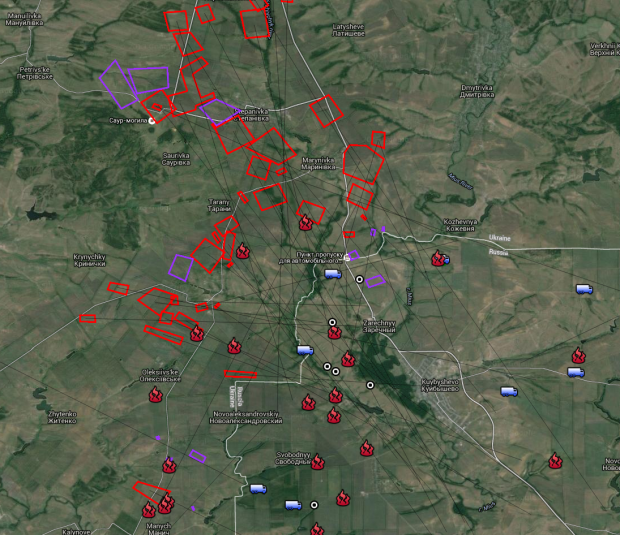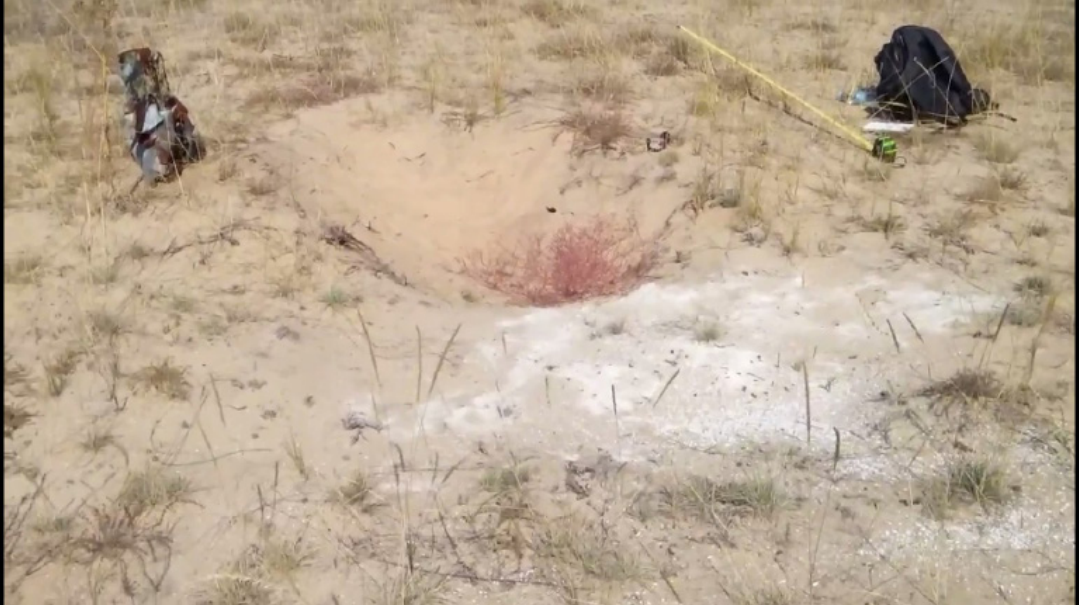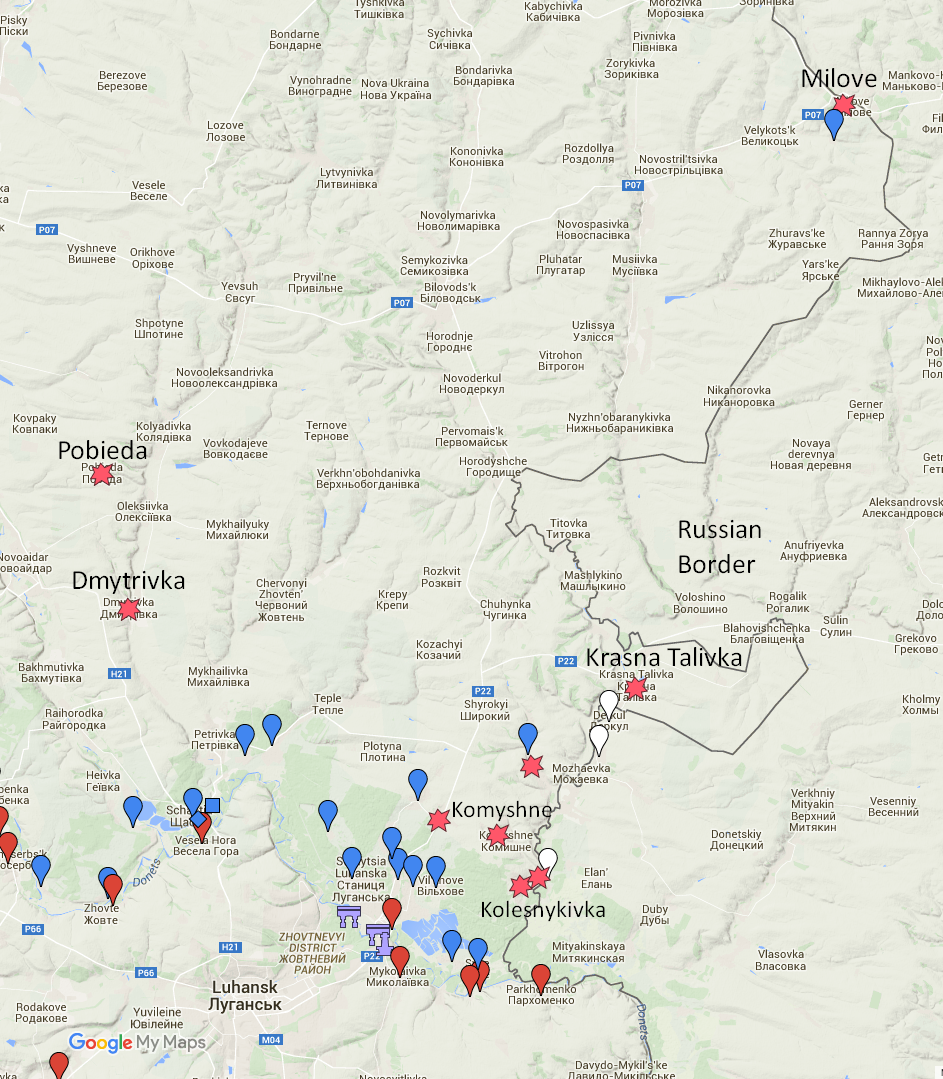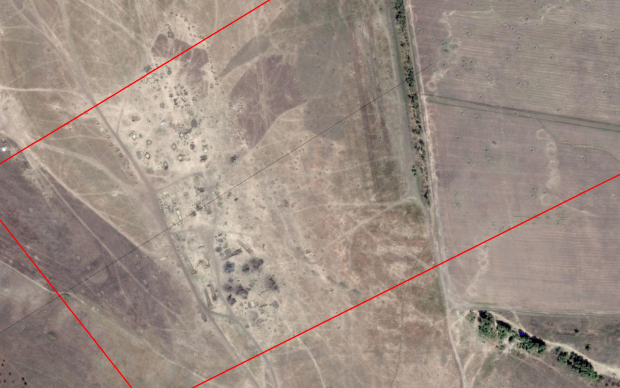Just over two years ago, on July 16, 2014, The Interpreter was able to geolocate and verify video footage showing rocket launchers in Russian territory firing into Ukraine, clearly demonstrating the international nature of the conflict.
https://youtu.be/-6RcvjvDq2c
While the downing of Malaysia Airlines flight MH 17 on the following day overshadowed this major escalation in the war, investigators like Sean Case, a British blogger based in Denmark, and the Bellingcat group continued to dig and assembled a huge collection of data drawn from Google Earth satellite imagery, identifying dozens of launch sites in Russia and hundreds of impact craters in Ukraine.

Map of impact and launch sites by Sean Case
In many cases the shape of the craters was clearly visible on the satellite photos, enabling investigators to conduct ballistic analysis and correlate them with launch sites.
Most recently, the Brussels-based International Partnership for Human Rights (IPHR) published a report detailing cross-border attacks in the Lugansk region.
While most of the impacts covered in the previous reports were in the Donetsk region, and all of the work was based on remote analysis of video footage, news reports or satellite images, the IPHR report, released on June 29 this year, draws on dozens of witness statements gathered in the field, along with measurements taken at the actual impact sites.

Photo of the crater created as a result of MLRS “Grad BM-21” explosion in the area of Yuhanivka and Kolesnykivka (coordinates 48.671845
39.699222) collected by IPHR team.
Critically, the report address attacks near several Ukrainian settlements that were located far from the front line with Russian-backed separatist forces.

The report describes repeated incidents of Russian heavy artillery and multiple-launch rocket systems, such as BM-21 Grads and BM-30 Smerch, firing at Ukrainian positions and settlements, sometimes assisted in targeting by drones or helicopters.
In addition, the IHPR present evidence of cross-border raids, with mortar or grenade launcher teams crossing the border into Ukrainian territory and conducting hit and run attacks.
In the case of one attack on August 8, 2014 near Milove, which itself lies right on the border, which runs down the street dividing the village from Russia’s Chertkovo, Ukrainian border guards were attacked with RPGs, recoilless rifles and RPO-A Shmel thermobaric missiles from an abandoned factory on the Russian side of the border. A little while later a nearby Ukrainian air defense unit was shelled with artillery.
The IHPR report details two groups of attacks near Milove, on July 1-2 and August 8, 2014, but a similar incident took place the following year, on March 24:
Ukraine Live: Governor Claims Russian Forces Attacked Air Defence Unit Far From Front Line. http://t.co/TurpANLhOE pic.twitter.com/52R13BYjNa
— The Interpreter (@Interpreter_Mag) March 24, 2015
The report also sheds light on one of the more dramatic claims from the Ukrainian military that we had so far been unable to verify.
On August 26, 2014, as Russian tanks and troops had begun a full-scale invasion, a Ukrainian military spokesman claimed:
“For the first time in the conflict, two Russian Mi-24 attack helicopters have fired unguided rockets at Ukrainian border guards.”
The military said that four Ukrainian border guards had been killed and three wounded in the attack, but never gave any further details on the location. In the chaos of the last days of August, news on what would have been a frightening escalation was submerged.
But the IHPR report cites several witnesses as saying that two Mi-24 helicopters and three BTR-82A armoured personnel carriers did indeed cross into Ukrainian territory in the early hours of August 25, during a skirmish between Ukrainian border guards and a group of unidentified fighters who had ambushed them near Krasna Talivka, a settlement which lies in a a pocket of Ukrainian territory bordered by Russia on three sides.
At least two Ukrainian border guards were killed according to the IHPR report.
Unfortunately the cross border attacks often inflicted a heavy toll on Ukrainian forces as the targets were some way from the front line, where troops were not dug in and were more likely to be relaxed.
In just one attack near Dmytrivka on September 3, 2014, 15 Ukrainian servicemen were killed when Russian Smerch rocket launchers fired several volleys of Tornado-S shells in the early hours of the morning.
Elsewhere the IHPR reports that as a result of an attack near Kolesnykivka on July 23, 13 border guards were killed and around 40 wounded.
Here is an account by Ukrainian soldier Yevgeniy Zhukov of a similar incident, when a Ukrainian camp near the Donetsk border village of Zelyonopolye was attacked from Russian territory with Grad rockets.
A little later we got in contact and found out about the great disaster! Our guys had been flat-out nailed by artillery! Caught by surprise.
Mike arrived at 4:15 and, literally 10 minutes after they stopped, huge blasts rolled out across the whole perimeter of the camp. Grads, following up 152 mm “wild boars.” And, after all that, the ammo began spewing up for 4-6 hours, and shrapnel whizzed off from these shells etc. Those people (who survived) lay under their vehicles…
For most, this was a huge shock! Because this site had never been shelled before, and the people who lived there, due to the circumstances, had simply let their guard down…
And this was not a battle outside Zelyonopolye, as the media reported, this was prepared in advance, a precisely rehearsed, massive and successful artillery bombardment of our soldiers’ base on borders of the Lugansk region from the Russian side. In other words, a knife in the back, cowardly and treacherous, knowing that we would not respond, destroying a host of lads and even more scorched vehicles. Most have developed psychological disorders, it was hell!
Nine of Zhukov’s comrades from the 79th Airborne Brigade were killed with “far more” dead from the other units deployed there, including the 24th Mechanised Brigade.
Last year Sean Case highlighted the visible craters at this exact site:

The IHPR report concludes on a point key to all discussion of the cross-border attacks of the summer of 2014 – their legal implication.
The IHPR report argues that the cross-border attacks clearly indicate “an armed conflict of international character, as defined in Common Article 2 of the Geneva Conventions of 1949.”
Furthermore:
The attacks on Kolesnykivka and Komyshne villages in Luhansk province can be qualified under Article 8 (2) (b) (iv) of the Rome Statute of the International Criminal Court (ICC), as intentional attacks against civilian objects and environment, causing damage to the environment which is clearly excessive in relation to the concrete and direct overall military advantage. It is possible to draw this conclusion, comparing the material, mental and contextual elements of this crime.
While there is an abundance of evidence that makes it clear that Russian military forces have been directly involved in the Ukraine war, demonstrable proof of attacks on Ukraine mounted from within Russian territory is perhaps the best indicator that this was an international conflict.